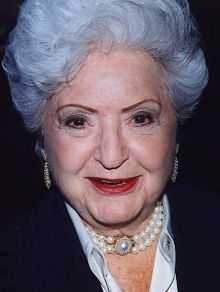Ruth Handler
| Ruth Handler | |
|---|---|
 | |
| Born |
Ruth Marianna Mosko November 4, 1916 Denver, Colorado, USA |
| Died |
April 27, 2002 (aged 85)[1] Los Angeles, California, USA |
Cause of death | Complications of surgery for colon cancer |
| Ethnicity | Jewish |
| Occupation | President of Mattel, Inc. |
| Employer | Mattel, Inc. |
| Successor | Robert A. Eckert |
| Spouse(s) | Elliot Handler (m. 1938–2002) |
| Children |
Barbara Handler Kenneth Handler |
| Parents |
Jacob Mosko Ida Rubenstein |
Ruth Marianna Handler (November 4, 1916 – April 27, 2002) was an American businesswoman, president of the toy manufacturer Mattel Inc., and is remembered for her role in marketing the Barbie doll.
Early life
Handler was born in Denver, Colorado to Polish Jewish immigrants Ida (née Rubenstein) and Jacob Mosko.[2]
The formation of Mattel
Her husband, Elliot Handler and his business partner, Harold "Matt" Matson, formed a small company to manufacture picture frames, calling it "Mattel" by combining part of their names ("Matt" and "Elliot"). Later, they began using scraps from the manufacturing process to make dollhouse furniture. The furniture was more profitable than the picture frames and it was decided to concentrate on toy manufacturing. The company's first big-seller was the "Uke-a-doodle", a toy ukulele.
Barbie: the beginning
Ruth Handler had noted that her daughter Barbara, who was becoming a pre-teen, played with paper dolls by pretending they were adults. Handler noted the limitations of the paper dolls, including how the paper clothing failed to attach well. She wanted to produce a 3-dimensional plastic "paper doll" with an adult body and a wardrobe of fabric clothing, but her husband and Mr. Matson thought parents would not buy their children a doll with a voluptuous figure. While the Handler family was vacationing in Europe, Ruth Handler saw the German Bild Lilli doll (which was not a children's toy, but rather an adult gag gift) in a Swiss shop and brought it home. The Lilli doll was a representation of the same concept Ruth had been trying to sell to other Mattel executives.
Once home, she reworked the design of the doll and named her Barbie after the Handlers' daughter, Barbara. Barbie debuted at the New York toy fair on March 12, 1959 but was not an immediate success. When Disney introduced The Mickey Mouse Club children's television show, Mattel invested heavily in television advertising. The TV commercials for the Barbie doll paid off and Barbie rocketed Mattel and the Handlers to fame and fortune. Subsequently, they would add a boyfriend for Barbie named Ken, after the Handlers' son, and many other "friends and family" to Barbie's world.
Later years
Handler was diagnosed with breast cancer in 1970. She had a modified radical mastectomy, which was often used at the time to combat the disease, and because of difficulties in finding a good breast prosthesis, she decided to make her own. Handler went on to found a company, Ruthton Corp., formed by her and Peyton Massey, which manufactured a more realistic version of a woman's breast, called "Nearly Me".
Though the Handlers took a more hands-off approach to their company's business practice after resigning, they still kept creating more ideas. One project Handler took on in the 1980s was Barbie and the Rockers. She was credited as a writer of the 1987 film Barbie and the Rockers: Out of this World. Handler was inducted into the Junior Achievement U.S. Business Hall of Fame in 1997.
She died in California from complications of surgery for colon cancer on April 27, 2002, aged 85.[3] Her husband Elliot died nine years later at the age of 95.
References
- ↑ Ruth Handler, Whose Barbie Gave Dolls Curves, Dies at 85 - New York Times
- ↑ Jewish Virtual Library: "Ruth Mosko Handler - (1916-2002) retrieved August 10, 2013
- ↑ Associated Press (April 28, 2002). "Creator of Barbie dies at 85". USA Today. Retrieved January 12, 2013.
- Gerber, Robin. Barbie and Ruth: The Story of the World's Most Famous Doll and the Woman Who Created Her. Harper/Collins, 2008.
External links
- Ruth Handler Papers.Schlesinger Library, Radcliffe Institute, Harvard University.
- Ruth Handler, Barbie Doll Invention
- Altman, Julie."Ruth Mosko Handler." Jewish Women: A Comprehensive Historical Encyclopedia. 20 March 2009. Jewish Women's Archive. January 5, 2010